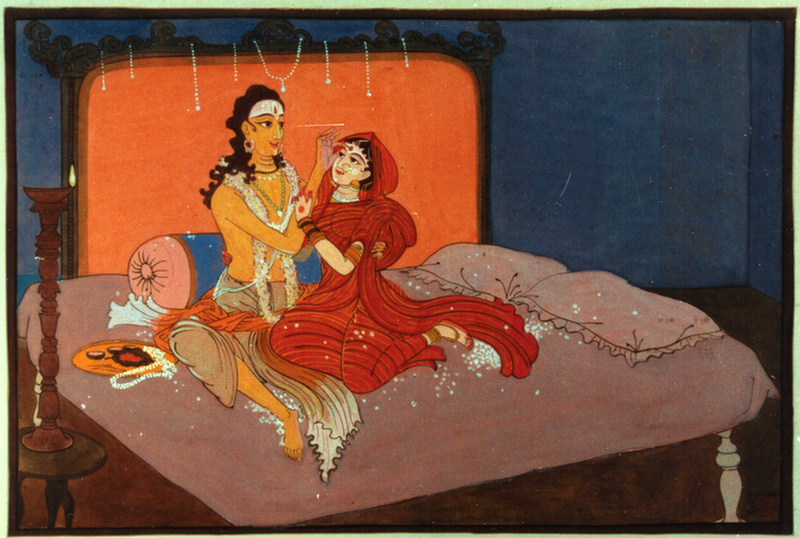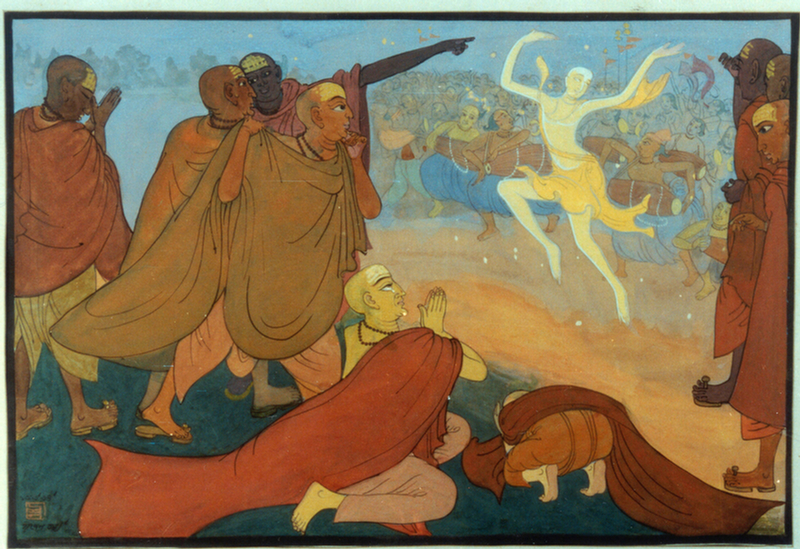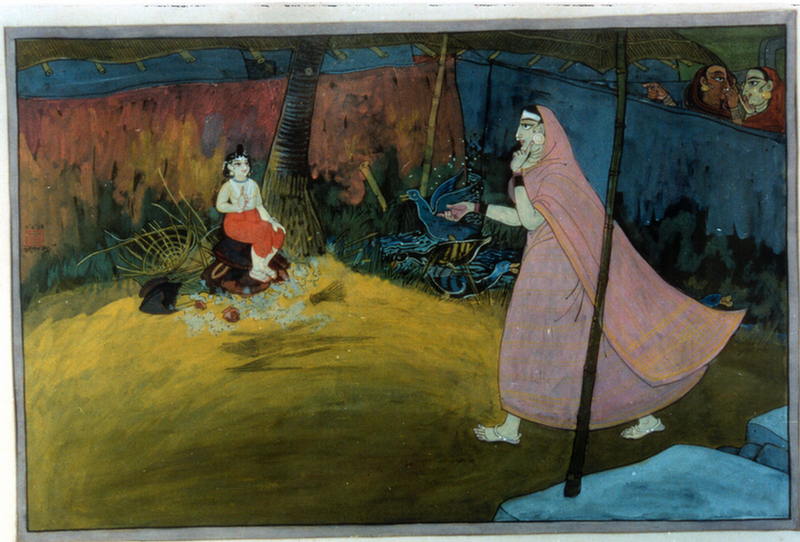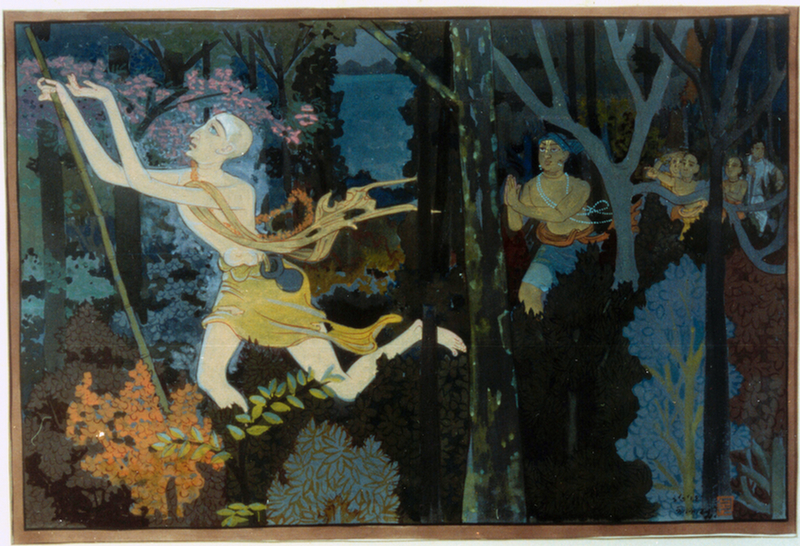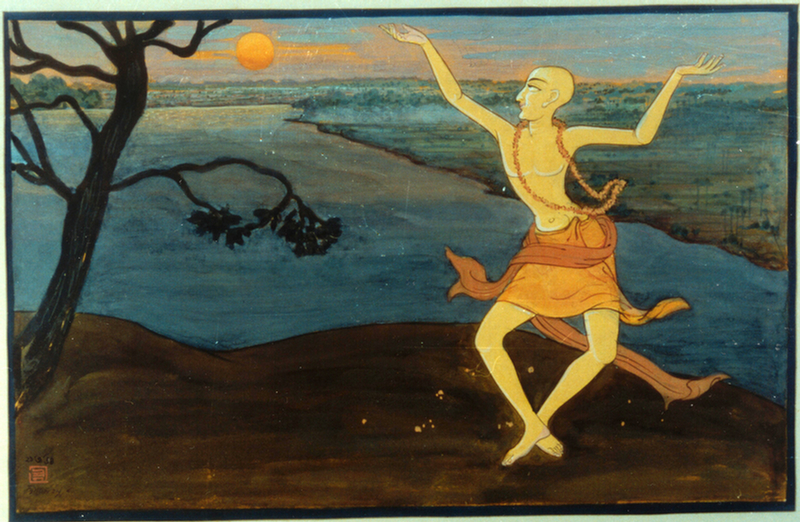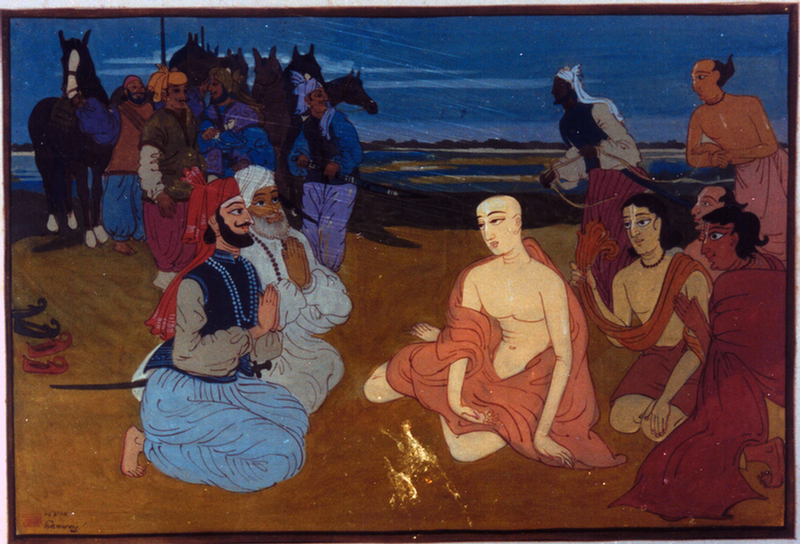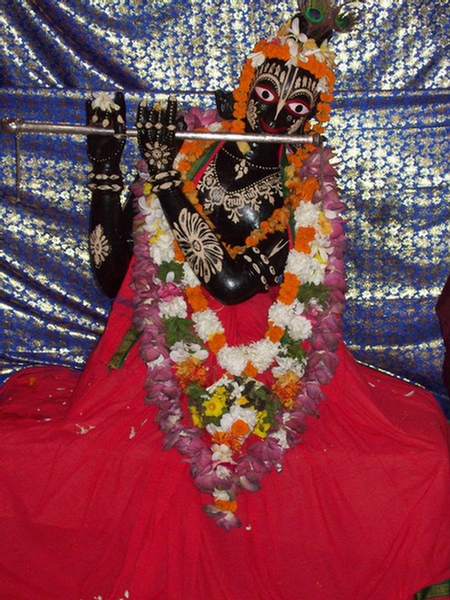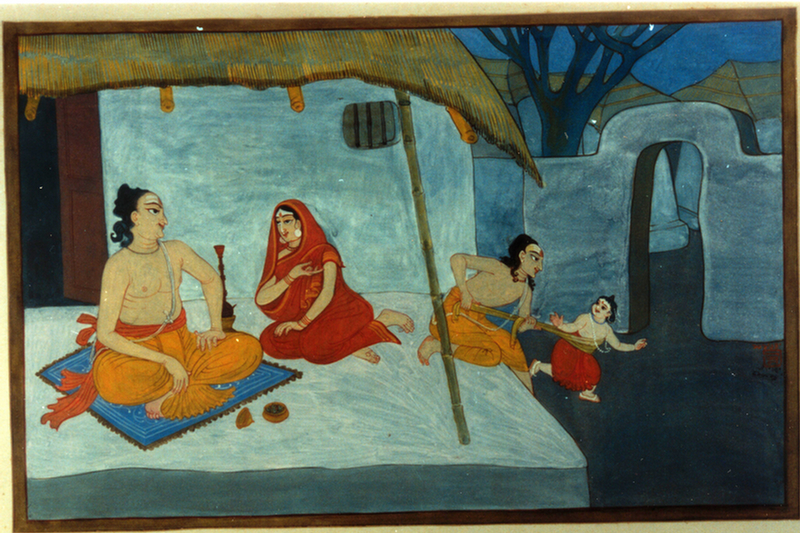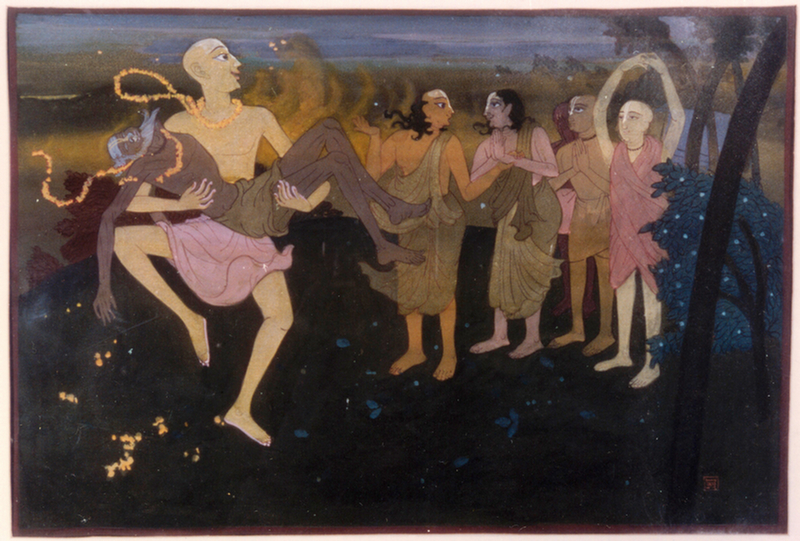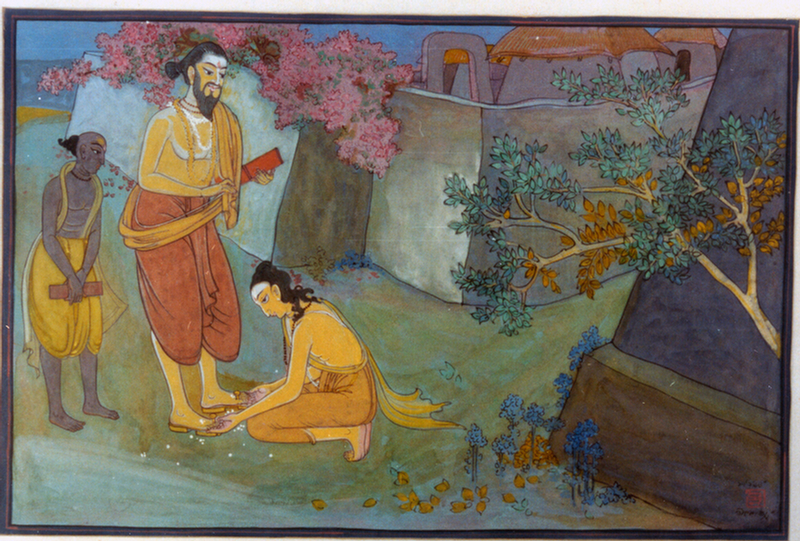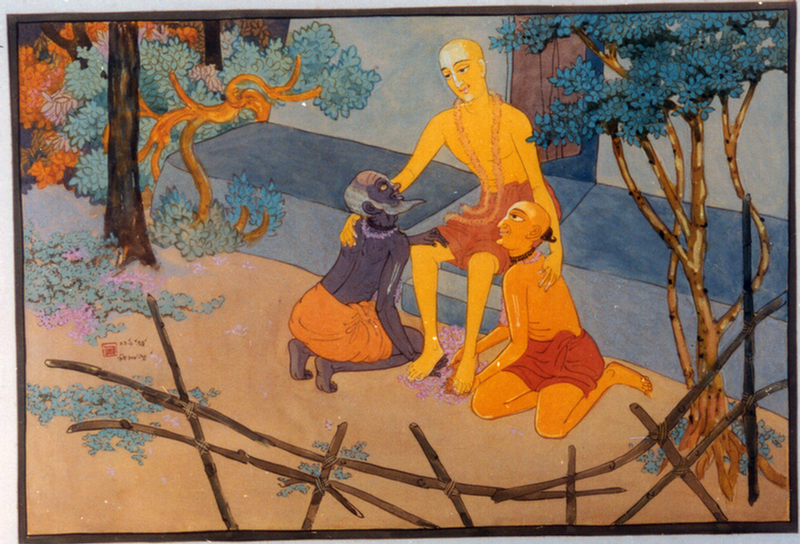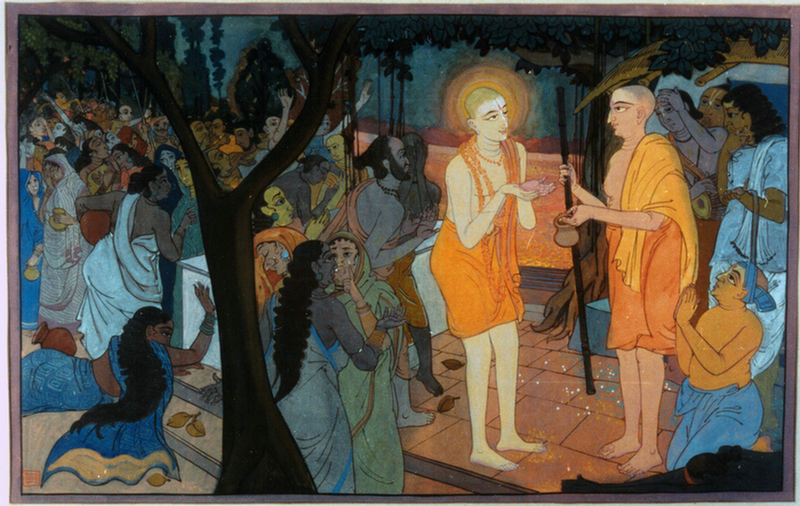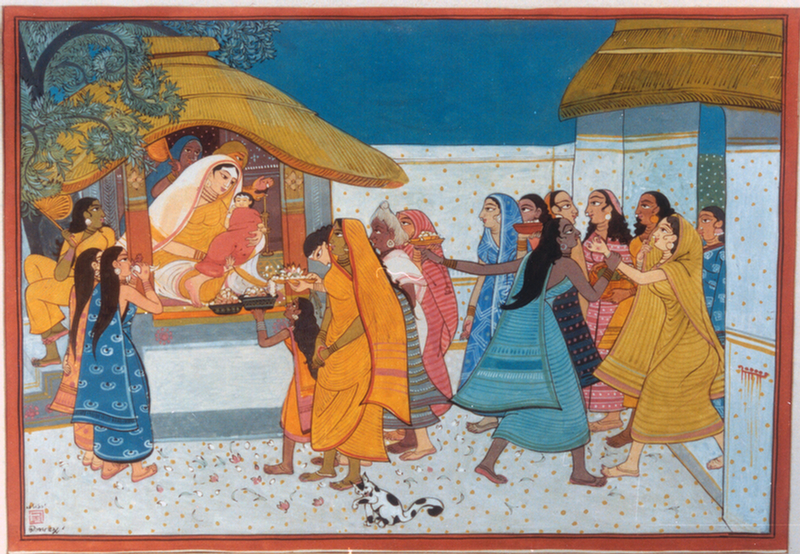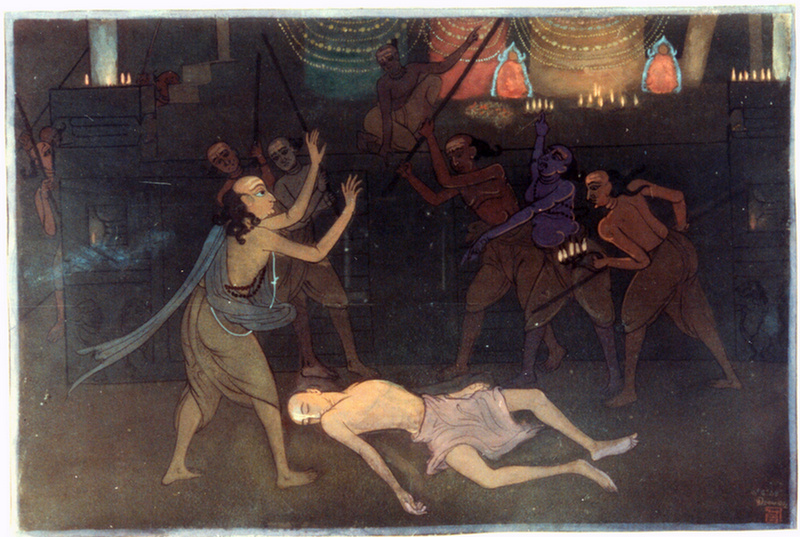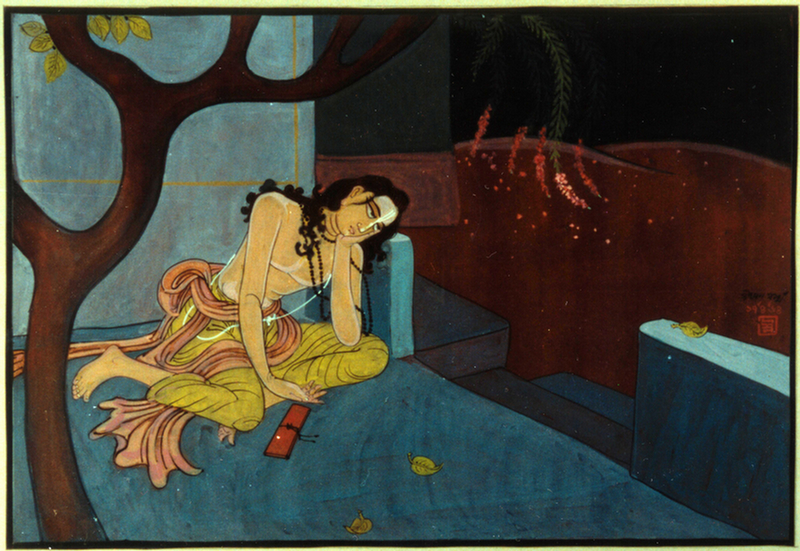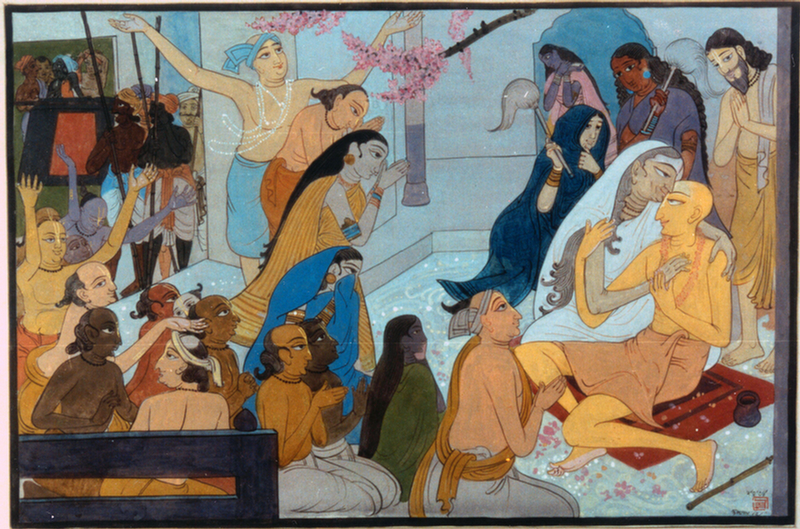From Back to Godhead
By Satsvarupa Dasa Goswami
Lord Caitanya Mahaprabhu, who was also known as Visvambhara (“Lord of the universe”), appeared in Bengal, India, 489 years ago and taught love of Krsna. The Vedic scriptures, such as the Vedas, Upanisads, Vedanta-sutra and especiallyBhagavad-gita and Srimad-Bhagavatam, all reveal Krsna to be the Supreme Truth and the dearmost friend of every living being. Lord Krsna says in Bhagavad-gita “Give up all other forms of religion and surrender to Me. I shall then protect you.” Lord Caitanya, therefore, urged everyone He met, “Surrender to Krsna. His holy name is the only shelter.”
Because thousands of years had passed since Krsna’s appearance on earth and because people had not fully understood Krsna from Bhagavad-gita, Lord Caitanya, as Krsna’s dearmost servant, showed everyone exactly how to render loving service to Krsna, just according to Krsna’s own words as revealed in Vedic literature. These Vedic writings were compiled 5,000 years ago, but when Lord Caitanya came He created a great revival of love for Krsna. Most importantly, Lord Caitanya delivered the chanting of Krsna’s holy names: Hare Krsna, Hare Krsna, Krsna Krsna, Hare Hare/ Hare Rama, Hare Rama, Rama Rama, Hare Hare.
Sri Krsna Caitanya, as He was also called, did not invent the chanting of Hare Krsna; He took it directly from the Vedic scriptures. The Brhan-naradiya Purana says: harer nama harer nama harer nama eva kevalam/ kalau nasty eva nasty eva nasty eva gatir anyatha: “Chant the holy name, chant the holy name, chant the holy name! In the Kali-yuga [the Age of Quarrel and Hypocrisy] there is no other way, no other way, no other way.” The Kalisantarana Upanisad also says that these sixteen words in thirty-two syllables Hare Krsna, Hare Krsna, Krsna Krsna, Hare Hare/ Hare Rama, Hare Rama, Rama Rama, Hare Hare are the most effective means for counteracting the contaminating effects of Kali-yuga.
According to the Vedic scriptures, the chanting is the only process perfectly suitable for the age in which Lord Caitanya appeared, Kali-yuga, a spiritually fallen age. Kali-yuga is still going on, and we shall feel its disruptive influence more and more. Therefore Lord Caitanya gave a great impetus to the Krsna consciousness movement by inaugurating sankirtana, the congregational chanting of the holy names. Indeed, He set in motion, by His own example, a movement that would spread all over the world as the greatest benediction for the people of today. Almost five hundred years ago, He Himself foretold, “The chanting of the names of Krsna will be heard in every town and village of the world.”
We know a great deal about the life and teachings of Lord Caitanya because His immediate followers wrote many books, all authoritatively based on the Vedic scriptures. His chief literary followers were known as the six Gosvamis. Among them, Jiva, Sanatana and Rupa especially wrote dozens of scholarly spiritual books proving bhakti, or love of Krsna, to be the ultimate goal of the Vedas. Krsnadasa Kaviraja and Vrndavana dasa Thakura also wrote authoritative biographies of Sri Krsna Caitanya, and many of their learned followers have contributed elaborations and expositions upon the philosophy of Lord Caitanya, thus establishing the basis for a complete and consistent spiritual movement.
As we observe the 489th anniversary of Lord Caitanya’s appearance, let us consider His significance for the people of the world today. Krsnadasa Kaviraja Gosvami, in his biography Sri Caitanya-caritamrta, describes the events leading to Sri Caitanya’s appearance. We shall try to relate them here, for they tell us much about His mission.
“To fulfill a particular desire within His mind, Lord Krsna, Vrajendra-kumara, decided to descend on this planet after mature contemplation.” Krsnadasa Kaviraja plainly declares that Lord Caitanya is Lord Krsna, the Supreme Personality of Godhead. Lord Caitanya’s advent is also mentioned in the Srimad-Bhagavatam:
krsna-varnam tvisakrsnam
sangopangastra-parsadam
yajnaih sankirtana-prayair
yajanti hi sumedhasah
“In this Age of Kali, people endowed with sufficient intelligence will worship the Lord, who is accompanied by His associates, by performing sankirtana-yajna [congregational chanting of Hare Krsna].” (Bhag. 11.5.32) This verse also describes that in the Age of Kali, Krsna will appear, but His complexion will be golden. When Lord Caitanya taught His disciple Sanatana how to detect a genuine incarnation of God, He pointed out that the activities and bodily hues of the incarnations are described in the scriptures. Since the time of Lord Caitanya, many men have posed as Gods or avataras, collected money and attracted followers, but such imposters never fool the experts who know the transcendental science.
The scriptures indicate that the incarnation for Kali-yuga is Sri Caitanya Mahaprabhu, who is also called Gauranga or Gaurasundara (Gaura means “gold”) because of His golden hue. His complexion is golden, and His activities engage everyone in chanting Hare Krsna. To enact His mission, He always appears with His associates. Thus Lord Caitanya is most often worshiped in His form of panca-tattva, in which He is accompanied by His immediate expansions Nityananda, Advaita, Gadadhara and Srivasa.
Caitanya-caritamrta describes that before Lord Krsna took birth as Lord Caitanya, He requested many of His devotees to precede Him. “Lord Krsna first allowed His family of superiors to descend on the earth.” (Cc. Adi 13.53) These included Sri Sacidevi and Jagannatha Misra, who were to appear as His mother and father; Madhavendra Puri, who was to appear as a great spiritual master in the line Sri Caitanya would follow; and Sri Advaita, Srivasa and Nityananda, three of the Lord’s principal associates who would appear as His elders in His pastimes. He also sent Haridasa Thakura, who, despite his birth in a Moslem family, would become the namacarya, or master of the holy name, celebrated for chanting 300,000 names of Krsna daily. In an important book called Gaura-ganoddesa-dipika, Kavi-karnapura has ascertained that the associates or family members of Lord Krsna in Krsna’s pastimes 5,000 years ago in Vrndavana reappeared in different roles in the pastimes of Lord Caitanya. Thus Jagannatha Misra and Sacidevi were formerly Nanda and Yasoda, the mother and father of Krsna; Nityananda was formerly Krsna’s brother, Balarama; and Advaita Acarya was an incarnation of Krsna’s Visnu expansion from whom all the universes emanate at the time of universal creation.
Sri Caitanya-caritamrta describes the birthplace of Lord Gaurasundara before the Lord’s advent: “Before the appearance of Lord Caitanya Mahaprabhu, all the devotees of Navadvipa used to gather in the house of Advaita Acarya. In these meetings of devotees, Advaita Acarya used to recite Bhagavad-gita and Srimad-Bhagavatam, decrying the paths of philosophical speculation and fruitive activity and establishing the superexcellence of devotional service.” (Cc. Adi-lila, 13.63-4)
Krsnadasa Kaviraja further mentions that devotional service to Lord Krsna is the actual conclusion of the Vedic scriptures. Although different sections of the Vedic literature teach different paths, staunch devotees of Lord Krsna reject other processes, such as philosophical speculation, yogic gymnastics and unnecessary austerities and rituals, for these are meant only to raise people gradually to devotional service. Krsna says at the end of His teachings in Bhagavad-gita, “Give up all other varieties of religion and just surrender to Me.” Devotees, therefore, are the topmost transcendentalists and so need not engage in any other process than devotional service. If one takes to another process but doesn’t recognize that love of the Supreme Person is the supreme goal, he cannot be accepted as a genuine transcendentalist, and his practice of yoga or meditation is a waste of time.
It is stated that the associates who preceded Lord Caitanya were reading Bhagavad-gita and Srimad-Bhagavatam exclusively. One who doesn’t know the conclusion may search through many literatures and philosophies inquiring for the ultimate. These two Vedic literatures, however, hold the cream of all the Vedas. Sridhara Svami, a great Vedic acarya (spiritual master), wrote, “The Gita which issued from the lotus-like lips of Padmanabha Himself [Lord Krsna], must be well assimilated; what is the use of a multiplicity of other scriptures?” Lord Caitanya Himself prescribed reading Srimad-Bhagavatam and Bhagavad-gita as primary because although the Vedas and Upanisads only hint at the Absolute Truth, that Truth is fully developed in the Gita, which records the spoken words of Krsna, and Srimad-Bhagavatam, which contains narratives about Krsna and His pure devotees.
The associates of Lord Caitanya are described as Vaisnavas, which means devotees of the Absolute Truth in His aspect as the Supreme Person. Caitanya-caritamrta continues: “In the house of Advaita Acarya, all the Vaisnavas took pleasure in always talking of Krsna, always worshiping Krsna and always chanting the Hare Krsna maha-mantra.” (Cc. Adi-lila 13.66) From this we can understand that the devotees who gathered at Advaita Acarya’s house were fully absorbed in Krsna consciousness, either through talking of Krsna on the basis of Bhagavad-gita and Srimad-Bhagavatam, worshiping the Lord in His form as the Deity, or chanting in kirtana (singing Hare Krsna) with musical instruments. Because such Vaisnavas understand that there is nothing but Krsna and His energy, they never forget Krsna for a moment, and they always engage their senses in some kind of devotional service to the Supreme Lord.
Caitanya-caritamrta goes on to cite the predominant mood of the assembled Vaisnavas: “But Sri Advaita Acarya Prabhu felt pained to see all the people without Krsna consciousness, simply merging in material sense enjoyment.” (Cc. Adi-lila 13.67) Such is the vision of all pure devotees. Srila Bhaktisiddhanta Sarasvati Thakura (the spiritual master of His Divine Grace A.C. Bhaktivedanta Swami Prabhupada) used to say, “There is no scarcity of anything within this world. The only item scarce is Krsna consciousness.” The devotee can see that for want of God consciousness people are suffering terribly. In ignorance, people think they can be happy without cultivating spiritual life, and so they absorb themselves in plans and activities just to satisfy their senses. Yet this only causes suffering, all over the world. Food shortages, fuel shortages, war and poverty are all directly traceable to humanity’s forgetfulness of its relationship to Krsna.
Material nature runs by strict laws, and Krsna consciousness is a science of how to live in harmony with the material and spiritual nature by acting always in loving relation to the Supreme Lord, who is in fact the supreme proprietor. Man acts as if no one were in charge but him, and so the masses of people are misled by capitalism, communism, consumerism, voidism and so many other godless “isms” Man breaks nature’s laws and suffers from the crises that result. A devotee onlooker is very much aggrieved to see this.
The same materialistic tendencies plagued Navadvipa 500 years ago, and so Advaita Acarya expressed His sorrow for the people. The Vaisnavas at His home were free of all anxiety themselves because of their participation in krsna-katha (topics about Krsna), but a Vaisnava is unhappy to see others unhappy. Another great Vaisnava, Prahlada Maharaja, whose life is described in Srimad-Bhagavatam, once prayed: “Saintly persons and ascetics generally travel alone, concerned only with their own salvation, but I am not like them. I do not want to go back to the kingdom of God alone, leaving all these bewildered people who have no other shelter but Your Lordship. Unless they can come with me, I shall not go back to Godhead.” A Vaisnava feels free of all difficulty, but he also feels compassion for those who have been duped into accepting a false civilization that will cause them only suffering in this life and the next.
“Vaisnava” is not a sectarian designation. Lord Jesus Christ and Lord Mohammed were also powerful Vaisnava personalities who worked to bring humanity to love of God. Only the presence of such Vaisnavas can save human society. Lord Caitanya was to appear in a community of such Vaisnavas, but with one difference: He Himself was the Supreme Lord, the object of the Vaisnavas’ prayers. Thus even though appearing as a devotee, He would be able to deliver love of Krsna directly.
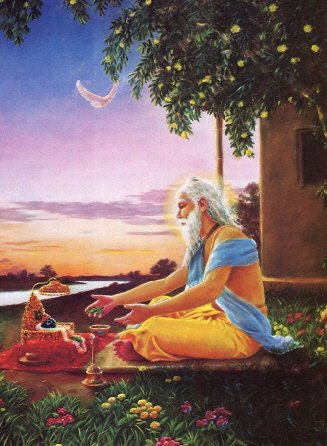
Advaita Acaraya
How Lord Caitanya descended at the specific request of Advaita Acarya is described in Caitanya-caritamrta: “Seeing the condition of the world, Sri Advaita Acarya began to think seriously of how all these people could be delivered from the clutches of maya (material illusion). Srila Advaita Prabhu thought: ‘If Krsna Himself appears to distribute the cult of devotional service, then only will liberation be possible for all people: ” (Cc. Adi-lila 13.68-69) His Divine Grace A.C. Bhaktivedanta Swami Prabhupada comments on this prayer: “Just as a condemned person can be relieved by a special favor of the chief executive head, the president or king, so the condemned people of this Kali-yuga can be delivered only by the Supreme Personality of Godhead Himself or a person empowered especially for this purpose. Srila Advaita Acarya Prabhu desired that the Supreme Personality Himself advent to deliver the fallen souls of this age.” Advaita Acarya thus promised to cause Lord Krsna to descend, and He began to worship the Supreme Lord with offerings of tulasi leaves and water of the Ganges. “By loud cries He invited Krsna to appear,” writes Krsnadasa Kaviraja, “and this repeated invitation attracted Lord Krsna to descend.”
Just as the prayers of Lord Brahma caused Lord Krsna to descend in Vrndavana, so the prayers of Krsna’s pure devotee, Advaita Acarya, caused Him to come again as Lord Caitanya. Of course, the Supreme Lord comes at His own will for His own mission, as stated in Bhagavad-gita: “Whenever and wherever there is a decline in religious practices, O Bharata, and a predominant rise of irreligion at that time I descend Myself. To deliver the pious and annihilate the miscreants, as well as to establish the principles of religion, I advent Myself millennium after millennium.” (Bg. 4.7-8) According to these verses, Lord Krsna appears specifically to mitigate the anxieties of pure devotees who are eager to see Him in His pastimes. Lord Krsna says that He appears in every millennium. This indicates that He also incarnates in the Age of Kali. Thus Lord Caitanya, as the incarnation of Krsna, the Personality of Godhead, is described secretly, indirectly, in the confidential parts of revealed scriptures such as the Upanisads, Mahabharata and Srimad-Bhagavatam.
The devotees of Lord Krsna are greatly attracted by the sankirtana movement of Lord Caitanya because instead of killing the miscreants, the Lord, through this movement, delivers them by His causeless mercy. When Rupa Gosvami first met Lord Caitanya, Rupa Gosvami therefore offered this prayer: “I offer You my most humble obeisances, for You are the most munificent avatara of Krsna, offering what was never offered before, even by Krsna Himself pure love of Krsna.” These are some of the special features of Sri Krsna Caitanya.
Lord Caitanya’s appearing as the son of Sacidevi and Jagannatha Misra cannot be compared to the birth of an ordinary conditioned soul. It is comparable only to Krsna’s appearance as the son of Devaki and Vasudeva. Before the birth of Lord Caitanya Mahaprabhu, Sacidevi, the wife of Jagannatha Misra, gave birth to eight daughters one after another, but just after their birth they died. Unhappy at the death of his children, and desiring a son, Jagannatha Misra worshiped the lotus feet of Lord Visnu. After this, Sacidevi gave birth to a highly qualified son, whom they named Visvarupa. Greatly pleased with their son, the husband and wife especially began to serve the feet of the Supreme Lord.
Sri Caitanya-caritamrta describes elaborately what happened next: “In the month of January in the year 1407 of the Saka Era [A.D. 1486], Lord Krsna entered the bodies of both Jagannatha Misra and Saci. Jagannatha Misra said to Sacimata: ‘I see wonderful things! Your body is effulgent, and it appears as if the goddess of fortune were now staying personally in my home. Anywhere and everywhere I go, all people offer me respect. Even without my asking, they voluntarily give me riches, clothing and paddy.’
“Sacimata told her husband: ‘I also see wonderfully brilliant human beings appearing in outer space, as if offering prayers.’
“Jagannatha Misra then replied: ‘In a dream I saw the effulgent abode of the Lord enter my heart. From my heart it entered your heart. I therefore understand that a great personality will soon take birth.”‘ (Cc. Adi-lila 13.80-5) Sacidevi did not become pregnant as an ordinary woman becomes pregnant because of sensual indulgence. But exactly as Krsna appeared in the heart of Devaki through the heart of Vasudeva, so Lord Caitanya appeared in the heart of Sacidevi through the heart of Jagannatha Misra.
While Sacidevi was pregnant, Nilambara Cakravarti (the grandfather of Sri Caitanya Mahaprabhu) astrologically calculated that in that month, at an auspicious moment, the child would be born. At the time of Lord Caitanya’s appearance, a wonderful natural phenomenon occurred a full lunar eclipse. Krsnadasa Kaviraja writes, “When the spotless moon of Caitanya Mahaprabhu became visible, what would be the need for a moon full of black spots on its body?”
In India all the followers of the Vedic scriptures customarily bathe in the Ganges or the sea as soon as there is a lunar or solar eclipse. Strict followers of the Vedic religion stand in the water throughout the eclipse and chant the Hare Krsna maha-mantra. At the time of Lord Caitanya’s birth such a lunar eclipse took place, and naturally the people standing in the water were chanting Hare Krsna, Hare Krsna, Krsna Krsna, Hare Hare/ Hare Rama, Hare Rama, Rama Rama, Hare Hare. Krsnadasa Kaviraja relates that not only were the followers of the Vedas chanting Hare Krsna, but the Mohammedans and others joined them, imitating the chanting. Thus Hindus and Moslems joined together in chanting the holy name of the Lord when Sri Caitanya Mahaprabhu appeared. It was miraculously appropriate that He who throughout His life would induce everyone to chant Hare Krsna appeared in the world at a moment when everyone was joyfully chanting because of the lunar eclipse, Certainly it signaled the advent of a great leader of sankirtana.
Krsnadasa Kaviraja relates that the whole world was induced to blissful chanting of the holy names by the appearance of Sri Caitanya Mahaprabhu. “All the ten directions became jubilant, as did the waves of the rivers. Moreover, all beings, moving and nonmoving, were overwhelmed with transcendental bliss… At that time Sri Advaita Acarya Prabhu, in His own house at Santipura, was dancing in a pleasing mood. Taking Haridasa Thakura with Him, He danced and loudly chanted Hare Krsna. But why they were dancing no one could understand… In this way all the devotees, wherever they were situated, in every city and every country, danced, performed sankirtana, and gave charity by mental strength on the plea of the lunar eclipse, their minds overwhelmed with joy.” (Cc. Adi-lila 13.97, 99, 103)
After the Lord’s appearance, respectable ladies of the neighborhood came to visit the newly born child, whose bodily color resembled shining gold. Among them, Sitadevi, who was Advaita Acarya’s wife and a recognized devotee, was astonished when she saw Visvambhara, for she could appreciate that except for a difference in color, the child was directly Krsna Himself.
Caitanya-caritamrta states, “Lord Caitanya is very merciful to anyone who hears this narration of His birth, and thus such a person attains the lotus feet of the Lord.” (13.122)
Krsnadasa Kaviraja writes that the pastimes of Lord Caitanya are unlimited and that he can give only a tiny part of them in his book Caitanya-caritamrta. Of that tiny part, we have here taken only a brief glimpse, as space would permit. The readers are advised to read Caitanya-caritamrta further, especially for an elaborate discussion, supported by scriptural references, concerning the identity of Lord Caitanya with Krsna Himself. There is also extensive material on the happy results of chanting of the Hare Krsna mantra.
His Divine Grace A.C. Bhaktivedanta Swami Prabhupada has recently completed his translation, with purports, of the entire Caitanya-caritamrta (11,555 verses). The Bhaktivedanta Book Trust has published three volumes of the set, and at least nine more volumes will be printed before it is completed. As Srila Prabhupada’s purports establish, the International Society for Krishna Consciousness is genuinely continuing Lord Caitanya’s mission of spreading Krsna consciousness all over the world.
We hope that these few lines on the appearance of Lord Caitanya will encourage interest in the potent reality of Lord Caitanya’s sankirtana movement. Krsna consciousness is authentically based on the Vedic literature and intended precisely for this age. Krsnadasa Kaviraja emphatically states that if one is at all interested in his self-betterment, he should not miss the chance to take to the teachings of Sri Caitanya Mahaprabhu: “Anyone who attains a human body but does not take to the cult of Sri Caitanya Mahaprabhu is baffled in his opportunity. Amrtadhuni is a flowing river of the nectar of devotional service. If after getting a human body one drinks the water in a poison pit of material happiness instead of the water of such a river, it would be better for him not to have lived, but to have died long ago.”
Source: http://m.dandavats.com/?p=19928
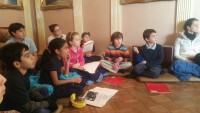
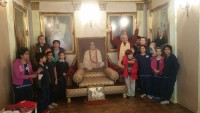
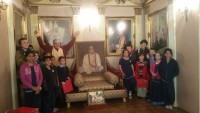

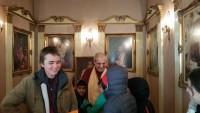
 nitya ātmāvyayaḥ śuddhaḥ
nitya ātmāvyayaḥ śuddhaḥ



